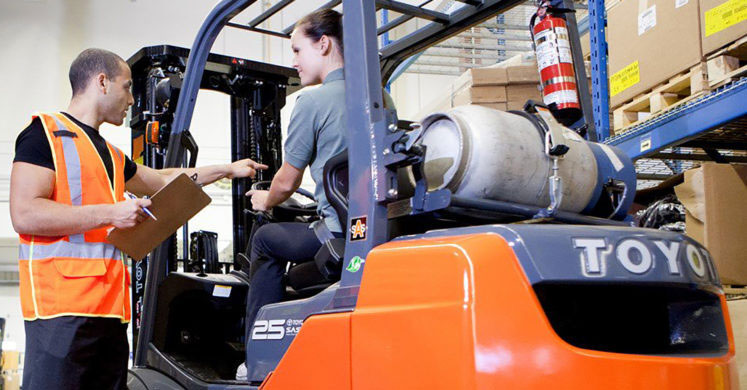It’s no secret that forklift safety is essential for operators and pedestrians. These frightening statistics from The Occupational Safety and Health Administration (OSHA) show just how crucial it is:
- OSHA’s most recent estimates indicate that between 35,000 and 62,000 injuries involving forklifts occur annually.
- On average, 95 people are seriously injured in a forklift accident every day, and one person is killed in a forklift accident every four days.
- 36% of forklift-related deaths are pedestrians.
We hope operator and pedestrian forklift safety is high on your importance list. Learn 11 tips to help improve forklift safety at your warehouse, distribution center, or facility.
- Increase pedestrian awareness of forklifts. Add warning lights to increase forklift travel visibility, backup alarms to alert pedestrians to nearby forklift traffic, and floor tape to mark pedestrian walkways.
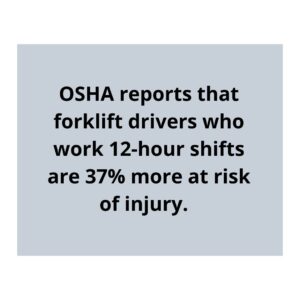 Look for forklifts with speed control features. Speed control features allow you to set the speed limits on your forklift drivers. Consider adding an aftermarket speed control kit if your forklift does not have one.
Look for forklifts with speed control features. Speed control features allow you to set the speed limits on your forklift drivers. Consider adding an aftermarket speed control kit if your forklift does not have one. - Limit forklift operators to shorter shifts. OSHA reports that forklift drivers who work 12-hour shifts are 37% more at risk of injury.
- You could also add an impact manager. An impact manager records the time and day of a forklift accident and measures the size of the impact so you can investigate and implement prevention measures. It also activates an alarm that turns off the forklift until a supervisor checks it out and enters a security code to regain function.
- Be extremely careful when tilting a raised mast. Tilting a raised forklift mast is a common cause of forklift accidents. Toyota’s Active Mast Function Control System limits forward and rear tilt speed to help prevent forward tip-overs.
- Don’t exceed the capacity of your forklift. Every forklift includes a data tag with weight limitations. Check yours to ensure you never exceed the limit.
- Make sure your forklift fleet has common safety features. Check for seatbelts, welded overhead guards, manually operated horns, operator assist grips, and skid-resistant entry and exit steps.
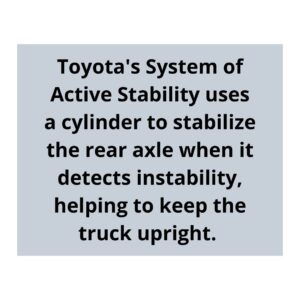
- Consider buying forklifts with advanced safety features. Toyota forklifts have advanced safety features, including its System of Active Stability, Active Mast Controls, and Automatic Forklift Levelers. These features help prevent tip-overs and other common forklift accidents. For example, Toyota’s System of Active Stability uses a cylinder to stabilize the rear axle when it detects instability, helping to keep the truck upright.
- Look for forklifts ranked #1 in safety. Toyota forklifts consistently rank #1 for safety in an independent study conducted by Peerless Research Group.
- Install mirrors and barriers. Mirrors allow forklift operators to see around blind spots, and walls can create a physical structure to help prevent serious injuries if an accident does occur.
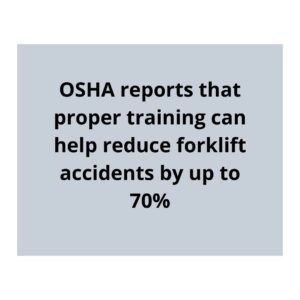 Sign up for Forklift Operator Safety Training. OSHA reports that proper training can help reduce forklift accidents by up to 70%. Our three-hour forklift operator safety training includes classroom and hands-on training by Toyota-certified trainers.
Sign up for Forklift Operator Safety Training. OSHA reports that proper training can help reduce forklift accidents by up to 70%. Our three-hour forklift operator safety training includes classroom and hands-on training by Toyota-certified trainers.
There are many ways to increase forklift safety, some depending on your specific facility. We offer complimentary safety checkups from experienced material handling professionals. Contact us to schedule a free safety consultation at your facility today.
Tags: forklift safety training, free resources